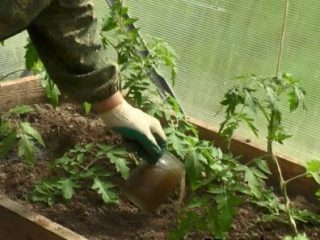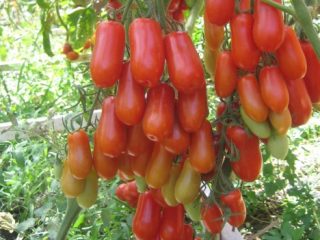Content
One of the new promising varieties is the mid-early and productive tomato Luxury Bunch. The tomatoes are a beautiful bright red color, round and aligned, great for whole-fruit canning. The variety is unpretentious in care, resistant to major diseases, and tolerates transportation and storage well.
Where and when appeared
The luxurious bunch is a super-new product among high-yielding red tomatoes. Siberian breeding scientists developed the variety for a short summer. The bushes develop correctly both in open ground and in greenhouse plantings.

Most summer residents are just trying to grow this tomato on their plots, so there are few reviews about it yet
Description of the tomato variety Luxurious bunch
Since the Luxury Bunch variety is of great interest to gardeners, it is worth getting acquainted with the characteristics and description of the tomato:
- The plant is a semi-determinate type.In favorable conditions it reaches a height of 1.8 m, and the average height is 1.2 m. The bushes are stocky and compact. They do not take up much space in the greenhouse.
- The tomato's erect stem is densely covered with medium green leaves. Side shoots grow rapidly, so the bushes need to be pruned in a timely manner.
- The fruit clusters are large, weighing up to 2 kg. The tomatoes are tight, deep red, round, with a spout, weighing from 50 to 80 g. When cut, the flesh is juicy, fleshy, without white veins and a stem.
- The taste is balanced, pleasant, preserved during heat treatment and twisting. The aroma is pronounced tomato.

Each bunch contains 20-25 fruits, which is why the variety is characterized as mega-yielding
Characteristics of tomato Luxurious bunch
Luxurious bunch are medium-sized nightshade bushes that are distinguished by their endurance and good adaptability. The varietal characteristics confirm this.
Ripening time
Up to seven flower clusters are formed on one bush. After flowering, fruit set begins. The harvest is harvested after 110-115 days. Ripe tomatoes can be eaten already at the end of August. But it all depends on the climate in a particular growing region.
Tomato yield Luxurious bunch
The luxurious bunch belongs to the category of high-yielding varieties. Reviews from gardeners indicate that up to 10 kg of marketable fruit can be harvested from one bush.

Removing lateral and lower stepsons accelerates ripening, but reduces overall yield
Resistance to diseases and pests
Resistance to diseases is high, but in case of violations in agricultural technology and in unfavorable years, prevention is required.Like any vegetable crop, the tomato is subject to attack by pests; regular inspection of the leaves is necessary.
Growing regions
Tomatoes can be grown in the southern regions (Caucasus, Krasnodar region, Volgograd, Rostov, Astrakhan regions). In warm and mild climates, the plant develops correctly in open ground and manages to produce a harvest. In the middle zone and in colder regions (Ural, Siberia, Krasnoyarsk Territory), semi-determinate varieties grow well in greenhouses.
Methods of use
Tomatoes of this variety can be eaten raw: in cold appetizers, salads, or in their pure form. In addition, they are suitable for making sauces, juices and are especially well suited for whole-fruit canning, as they are not too large and have a strong skin that is resistant to cracking.

Universal use increases the value of the Luxury Bunch variety
Advantages and disadvantages
The semi-determinate variety is a special middle ground. It does not require active care, but still produces consistently high yields.

The fruits ripen together and almost simultaneously
Pros:
- high resistance to diseases and temperature changes;
- unpretentiousness and ease of care;
- maintaining good taste when salting, canning and pickling;
- ripe fruits are of the same round shape and do not crack on the bushes;
- high transportability and keeping quality without loss of presentation.
Minuses:
- high levels of humidity can provoke fungal diseases.
Rules and landing scheme
Seedlings are planted in open ground in May. Regardless of the region, this is only possible when the air temperature is set at +15 °C and above.

The soil for growing tomatoes must be loose, nutritious, capable of conducting and retaining moisture well.
Planting pattern:
- First of all, you need to make a distance of 0.7 m between the rows, and 0.5 m between the holes. Install wooden pegs.
- Dig holes 25-30 cm deep and put wood ash (1 tsp) at the bottom of each.
- Place tomato seedlings in the holes along with a lump of earth.
- Lightly compact the soil and shade the seedlings from direct sunlight.
Care instructions
Excessive watering is harmful for an adult tomato, but drying out the soil also has a bad effect on the plant. The frequency of watering is determined taking into account the age of the tomato and the climate of the region.
The soil is moistened to a depth of 10 cm and loosened after each watering. This helps minimize the risk of crusting on the soil surface.
Having completed loosening, the tree trunk circle is covered with a layer of mulch. Straw, humus or expanded clay are used for this.
Fertilizers begin to be applied 1.5-2 weeks after planting. You can use ammonium nitrate or superphosphate.

Fertilizers are used in liquid form, combined with irrigation
Forming tomatoes Luxurious bunch
When growing Luxury Bunch tomatoes in a greenhouse, special attention should be paid to the formation of bushes. Tomatoes are formed into two trunks, breaking off the stepsons to the side. One stepson is left below, and after the fifth ovary appears, the top is pinched, leaving 2-3 leaves above the last inflorescence.

In the absence of formation, tomatoes grow greatly and do not produce a harvest.
Pest and disease control
Almost all tomato diseases can be easily prevented by a number of preventive actions. When growing bushes in a greenhouse or greenhouse, it is necessary to systematically ventilate and disinfect with fungicides, for example, Bordeaux mixture.
To increase resistance to diseases, you need to feed the crop with complex mineral fertilizers.
Conclusion
The Luxury Bunch tomato is an unpretentious and persistent representative of the Solanaceae family, suitable for growing in open beds. By following all care recommendations, you can reap a bountiful harvest of delicious fruits.
Reviews from gardeners about the Luxury Bunch tomato








